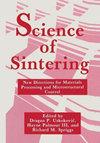硅藻土制备陶瓷单体:煅烧温度对二氧化硅相变的影响
IF 1.4
4区 材料科学
Q3 MATERIALS SCIENCE, CERAMICS
引用次数: 0
摘要
北马其顿比托拉附近的硅藻土具有低容重(0.61 ~ 0.69 g/cm3)、高吸水率(75 ~ 81%)和高孔隙率(66 ~ 72%)的特点。用电感-质谱法测定硅藻土的化学成分,得到以下结果:SiO2 (63.69 wt%)、Al2O3 (11.79 wt%)、Fe2O3 (5.95 wt%)、MnO (0.15 wt%)、TiO2 (0.65 wt%)、CaO (1.51 wt%)、MgO (2.24 wt%)、P2O5 (0.13 wt%)、K2O (1.64 wt%)、Na2O (0.93 wt%)、LOI (11.21 wt%)。粘土硅藻土样品的XRPD数据主要描述了结晶行为,非晶相少量存在。结晶矿物相主要有:二氧化硅(石英)、长石(斜长石)、云母(白云母)、绿泥石和白云石。扫描电镜和透射电镜结果表明,微孔和纳米结构的存在范围为250 ~ 600 nm。将黏土硅藻土在900℃、1000℃和1100℃三种温度下烧结1 h。C表现出一定的热稳定性和新相(莫来石和毛石)的形成,使所分析的硅藻土适用于生产各种类型的陶瓷、建筑和隔热材料。本文章由计算机程序翻译,如有差异,请以英文原文为准。
Fabrication of ceramic monoliths from diatomaceous earth: effects of calcination temperature on silica phase transformation
The raw diatomaceous earth from the vicinity of Bitola (North Macedonia) showed low bulk density (0.61-0.69 g/cm3), high-water absorption (75-81%) and porosity (66- 72%). The chemical composition was determined with ICP-MS, revealing the following results for the diatomaceous earth: SiO2 (63.69 wt%), Al2O3 (11.79 wt%), Fe2O3 (5.95 wt%), MnO (0.15 wt%), TiO2 (0.65 wt%), CaO (1.51 wt%), MgO (2.24 wt%), P2O5 (0.13 wt%), K2O (1.64 wt%), Na2O (0.93 wt%), LOI (11.21 wt%). XRPD data of the examined sample of clayey diatomite mainly depicted crystalline behavior with a small presence of amorphous phase. The crystalline mineral phases mainly comprise: silica (quartz), feldspars (plagioclase), mica (muscovite), chlorites and dolomite. SEM and TEM results show cased presence of micro- and nanostructures with pores ranging from 250 to 600 nm. The clayey diatomite was sintered at three temperatures (900, 1000 and 1100?C) for a period of 1 h. XRPD of the sintered samples at 1100?C showed certain thermal stability and formation of new phases (mullite and tridymite) that makes the analyzed diatomaceous earth suitable for production of various types of ceramic, construction and thermal insulating materials.
求助全文
通过发布文献求助,成功后即可免费获取论文全文。
去求助
来源期刊

Science of Sintering
工程技术-材料科学:硅酸盐
CiteScore
2.50
自引率
46.70%
发文量
20
审稿时长
3.3 months
期刊介绍:
Science of Sintering is a unique journal in the field of science and technology of sintering.
Science of Sintering publishes papers on all aspects of theoretical and experimental studies, which can contribute to the better understanding of the behavior of powders and similar materials during consolidation processes. Emphasis is laid on those aspects of the science of materials that are concerned with the thermodynamics, kinetics and mechanism of sintering and related processes. In accordance with the significance of disperse materials for the sintering technology, papers dealing with the question of ultradisperse powders, tribochemical activation and catalysis are also published.
Science of Sintering journal is published four times a year.
Types of contribution: Original research papers, Review articles, Letters to Editor, Book reviews.
 求助内容:
求助内容: 应助结果提醒方式:
应助结果提醒方式:


